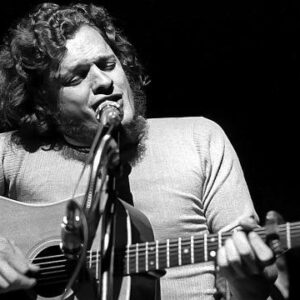Harry Chapin was an American singer-songwriter renowned for his folk rock compositions such as “Taxi,” “W*O*L*D,” and “Sniper.” His self-described “story song”, a narrative genre that borrowed extensively from older talking blues and primarily dealt with issues connected to wasted opportunities, terrible ironies, and life’s hypocrisy, brought him tremendous recognition. Harry, one of the sons of the famed drummer Jim Chapin, was introduced to music from a young age. As a child, he played the trumpet before switching to the guitar. As a youngster, he performed with his siblings and occasionally with his father, who had divorced his mother when Harry was small. Before beginning his work as a documentary filmmaker, he graduated from Brooklyn Technical High School and attended Cornell University. His debut album ‘Heads & Tales’ was a success and he quickly shifted gears to pursue a musical career. In addition to gaining a reputation as a refined folk rock performer, he also became noted for his performances on Broadway. In addition to being an exceptional vocalist, he was a dedicated humanitarian who sought to alleviate world poverty. At the age of 38, a catastrophic accident claimed the life of this extraordinary individual.
Youth and Early Life
Harry Forster Chapin was born in Brooklyn, New York City, United States, on December 7, 1942, to Jeanne Elspeth (née Burke) and Jim Chapin, a prominent percussionist. His father had collaborated with Tommy Dorsey and Woody Herman.
Tom and Steve, two of Harry’s brothers, also became musicians in the future. He began playing trumpet as a child before picking up the guitar. Around the age of eight, his parents divorced, and he moved in with his mother.
He began singing with the Brooklyn Boys Choir after attending the renowned Greenwich House Music School on Barrow Street in Greenwich Village and receiving training there. In addition to performing with his brothers as a teenager, their father occasionally joined them on drums.
In 1960, he graduated from Brooklyn Technical High School and attended the United States Air Force Academy for a brief time. He also attended Cornell University but did not complete a degree program.
Harry Chapin’s Career
Harry Chapin’s initial professional decision, despite his passion for music, was to become a documentary filmmaker. In 1968, he directed “Legendary Champions,” which was nominated for an Academy Award for best documentary. His career as a documentary filmmaker was brief, as he quickly changed his concentration to music.
In 1971, he began performing with John Wallace, Tim Scott, and Ron Palmer in various venues. He also produced an unsuccessful record alongside his brothers Tom and Steve.
In 1972, he published his debut album, Heads & Tales. It was somewhat successful and gave rise to the popular track “Taxi.” In short succession, he released another album titled “Sniper and Other Love Songs” the same year.
His folk-rock tunes attracted a large fan base, and they eagerly anticipated his next album. In the years that followed, he published the albums Short Stories’ (1973), ‘Verities & Balderdash’ (1974), ‘Portrait Gallery’ (1975), and ‘Greatest Stories Live’ (1976). (1976). His single ‘Cat’s in the Cradle’ from 1974 was a huge smash.
He began working on Broadway plays in the 1970s. He created and performed the 1975 musical “The Night That Made America Famous” and also composed the music and lyrics for the posthumously released musical “Cotton Patch Gospel.”
The 1978 album Living Room Suite’ featured the songs ‘It Seems You Only Love Me When It Rains,’ ‘Why Do Little Girls,’ ‘Flowers Are Red,’ and ‘Someone Said.’
1981’s ‘Sequel’ was the final complete album issued by Harry during his lifetime. The title track ‘Sequel’ describes additional events in the life of Harry and Sue, the protagonists of his 1972 hit song ‘Taxi.’
Harry’s Major Opera
“Taxi” was his first huge hit song. Considered a career-defining piece, the song contributed to Chapin’s musical style and notoriety. The song narrates the narrative of Harry, a cab driver, who recognizes his ex-lover as he picks up a female customer on a rainy night.
In December 1974, his folk-rock song “Cat’s in the Cradle” topped the Billboard Hot 100. It became his most well-known work and a cornerstone of folk-rock music. The song was nominated for the Best Male Pop Vocal Performance Grammy in 1975.
Works for Charity
Harry Chapin was an individual who believed in contributing to society. One of the humanitarian initiatives he was committed to be the fight against world hunger. With radio personality Bill Ayres, he co-founded the organization World Hunger Year.
Additionally, he performed at various charity performances, the proceeds from which were utilized to fund World Hunger Year.
Awards & Achievements
In December 1987, Chapin was posthumously given the Congressional Gold Medal for his advocacy on social issues.
Personal History and Legacy
Harry Chapin met New York socialite Sandy Cashmore (née Gaston) in 1966. She was nine years older than he. The pair quickly fell in love and wed. As a result of his marriage, he became the stepfather to Sandy’s three children from a previous relationship, and the couple went on to produce two children of their own.
The catastrophe claimed his life on July 16, 1981. He was working on numerous songs that were released posthumously at the time of his death.
One month after his death, the Lakeside Theatre at Eisenhower Park in East Meadow, New York, was renamed the “Harry Chapin Lakeside Theatre” during a tribute concert.
Estimated Net Worth
At the time of his death in 1981, American singer and songwriter Harry Chapin had a net worth of $1 million. Perhaps his most famous song is “Cat’s in the Cradle.”
Harry Chapin was born in December 1942 in New York City, New York, and he died in July 1981. He performed the harmonica, guitar, piano, and trumpet. During the 1970s, Chapin was one of the highest-paid and most popular artists.


